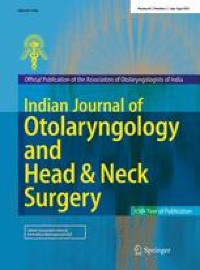|
Αρχειοθήκη ιστολογίου
-
►
2023
(138)
- ► Φεβρουαρίου (74)
- ► Ιανουαρίου (64)
-
►
2022
(849)
- ► Δεκεμβρίου (61)
- ► Σεπτεμβρίου (74)
- ► Φεβρουαρίου (65)
-
▼
2021
(2936)
- ► Δεκεμβρίου (59)
- ► Σεπτεμβρίου (180)
-
▼
Μαΐου
(293)
-
▼
Μαΐ 09
(17)
- Impact of staging on survival outcomes: a nationwi...
- Extreme elevation of acute phase reactants and sho...
- BRAF inhibitor treatment is feasible in the oldest...
- A case of hyperprolactinaemia in a patient with me...
- Prognostic impact of thyroid dysfunctions on progr...
- Impact of the development of immune related advers...
- Olfactory Neuroblastoma: A Novel Site of Presentation
- Patient Reported Outcomes of Scalp and Forehead Re...
- Anterior and Central Skull Base Fibrous Dysplasia:...
- Partial Middle Turbinectomy Versus Medialization S...
- Studying nerve transfers: Searching for a consensu...
- A review of the impact of hearing interventions on...
- Asymptomatic swallowing disorders may be present i...
- Quality of life in vestibular schwannoma: a compar...
- Self-reported smell and taste recovery in coronavi...
- Intradural extraarachnoid sutureless technique com...
- Incus Autograft Partial Ossicular Reconstruction P...
-
▼
Μαΐ 09
(17)
- ► Φεβρουαρίου (325)
-
►
2020
(1624)
- ► Δεκεμβρίου (293)
- ► Σεπτεμβρίου (234)
- ► Φεβρουαρίου (28)
-
►
2019
(13362)
- ► Δεκεμβρίου (19)
- ► Σεπτεμβρίου (54)
- ► Φεβρουαρίου (5586)
- ► Ιανουαρίου (5696)
-
►
2018
(66471)
- ► Δεκεμβρίου (5242)
- ► Σεπτεμβρίου (5478)
- ► Φεβρουαρίου (4835)
- ► Ιανουαρίου (5592)
-
►
2017
(44259)
- ► Δεκεμβρίου (5110)
- ► Σεπτεμβρίου (5105)
-
►
2016
(7467)
- ► Δεκεμβρίου (514)
- ► Σεπτεμβρίου (1038)
- ► Φεβρουαρίου (793)
Αναζήτηση αυτού του ιστολογίου
Κυριακή 9 Μαΐου 2021
Impact of staging on survival outcomes: a nationwide real-world cohort study of metastatic uveal melanoma
Extreme elevation of acute phase reactants and shock secondary to dabrafenib–trametinib
|
BRAF inhibitor treatment is feasible in the oldest-old advanced melanoma patients
|
A case of hyperprolactinaemia in a patient with metastatic melanoma
|
Prognostic impact of thyroid dysfunctions on progression-free survival in patients with metastatic melanoma treated with anti-PD-1 antibodies
|
Impact of the development of immune related adverse events in metastatic melanoma treated with PD -1 inhibitors
|
Olfactory Neuroblastoma: A Novel Site of Presentation
|
Patient Reported Outcomes of Scalp and Forehead Reconstruction for Defects Following Oncological Resections (North-East Indian Tertiary Cancer Centre Study)
|
Anterior and Central Skull Base Fibrous Dysplasia: A 12 Years’ Experience
|
Partial Middle Turbinectomy Versus Medialization Suturing of Middle Turbinate in the Management of Sinonasal Polyposis: A Comparative Study
|
Studying nerve transfers: Searching for a consensus in nerve axons count
|
A review of the impact of hearing interventions on social isolation and loneliness in older people with hearing loss
|
-
This protocol presents an in vitro live-imaging phagocytosis assay to measure the phagocytic capacity of astrocytes. Purified rat astrocyt...
-
Association française pour l'étude du cancer [Imatinib in the treatment of chronic myeloid leukemia in Morocco]. Related Articles [Im...
-
A Case of Miller Fisher Syndrome Due to the Use of Cemiplimab : No abstract available Miller Fisher syndrome is a rare, acquired n...








